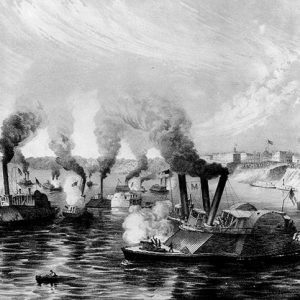calsfoundation@cals.org
USS Monarch
The sidewheel steam ram Monarch saw extensive service with Lieutenant Colonel Charles Rivers Ellet’s Ram Fleet as part of the Union’s Western Gunboat Fleet during the Civil War, including operations on the White River against Fort Hindman, during the ongoing battle for control of significant interior rivers in the Trans-Mississippi Department.
Originally built as a towboat in Fulton, Ohio, in 1853, the Monarch was purchased by the U.S. Army and commissioned at Pittsburgh, Pennsylvania, in April 1862. The Monarch joined Ellet’s Ram Fleet in May, with Captain R. W. Sanford in command. The Monarch’s first service consisted of scouting Fort Pillow on the Mississippi River. Afterward, the vessel participated in the Battle of Memphis on June 6, along with the Benton, Louisville, Carondelet, St. Louis, Cairo, and Queen of the West. During this engagement, the Monarch rammed the Confederate vessels Colonel Lowell and General Beauregard as the other Union vessels sank or damaged seven ships of the Confederate River Defense Fleet. These losses essentially eliminated the River Defense Fleet as an effective counter to the Union’s Western Gunboat Fleet and helped secure Union control of the upper Mississippi River. On June 26, the Monarch and Lancaster pursued the cotton-clad ram General Earl Van Dorn on the Mississippi and Yazoo rivers, eventually forcing the Confederates to burn the vessel near Yazoo City, Mississippi, to avoid capture.
As part of a twelve-ship flotilla, the Monarch participated, under Ellet, in the January 11, 1863, capture of Fort Hindman at Arkansas Post on the Arkansas River. The Monarch pursued a retreating Confederate force for twelve miles, shelling the woods to its right, until shallow waters prevented further action. The Monarch then moved up the Yazoo River to Greenville, Mississippi, to assist in efforts against Confederate guerrillas.
Through the summer of 1863, the Monarch served in operations against Vicksburg, Mississippi, and in the Yazoo River, bombarding Confederate shore batteries and sweeping torpedo mines. It was also a counter to Confederate use of the steamer Paul Jones.
The surrender of Vicksburg and the defeat of Confederate naval forces on the western rivers brought an end to the Monarch’s service, and the navy placed the vessel in reserve in 1864. In July 1865, the navy sent the Monarch to Mound City, Illinois, where it was dismantled.
For additional information:
Dictionary of American Naval Fighting Ships. http://www.history.navy.mil/research/histories/ship-histories/danfs.html (accessed December 7, 2021).
The War of the Rebellion: A Compilation of the Official Records of the Union and Confederate Armies. Series 1, Vol. 17, Part 1. Washington DC: Government Printing Office, 1886.
The War of the Rebellion: A Compilation of the Official Records of the Union and Confederate Armies. Series 1, Vol. 17, Part 2. Washington DC: Government Printing Office, 1886.
The War of the Rebellion: A Compilation of the Official Records of the Union and Confederate Armies. Series 1, Vol. 24, Part 1. Washington DC: Government Printing Office, 1889.
The War of the Rebellion: A Compilation of the Official Records of the Union and Confederate Armies. Series 1, Vol. 24, Part 3. Washington DC: Government Printing Office, 1889.
Robert Patrick Bender
Eastern New Mexico University–Roswell
 Civil War through Reconstruction, 1861 through 1874
Civil War through Reconstruction, 1861 through 1874 Military
Military ACWSC Logo
ACWSC Logo  Destruction of Rebel Fleet
Destruction of Rebel Fleet  USS Monarch
USS Monarch 




Comments
No comments on this entry yet.